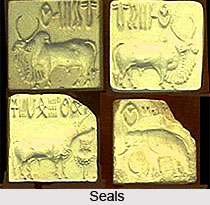 Various researches suggest that agriculture and allied activities were the main occupation and trade in Indus Valley Civilization. Like other civilisations of Egypt, Greece and Mesopotamia Indus valley civilisation also grew on the floodplains of Indus River. Many of the towns were also built upon the shores of this river. The Harappans were agriculturalists and their economy was entirely dominated by horticulture. It is also believed that there were massive granaries in each city then and Indus River valley was pretty fertile. Many of the Harappan seals had pictures of animals that imply a wet and marshy environment, such as rhinoceroses, elephants, and tigers. They also had a large variety of domesticated animals. Their agricultural activities were supported by heavy rainfall.
Various researches suggest that agriculture and allied activities were the main occupation and trade in Indus Valley Civilization. Like other civilisations of Egypt, Greece and Mesopotamia Indus valley civilisation also grew on the floodplains of Indus River. Many of the towns were also built upon the shores of this river. The Harappans were agriculturalists and their economy was entirely dominated by horticulture. It is also believed that there were massive granaries in each city then and Indus River valley was pretty fertile. Many of the Harappan seals had pictures of animals that imply a wet and marshy environment, such as rhinoceroses, elephants, and tigers. They also had a large variety of domesticated animals. Their agricultural activities were supported by heavy rainfall.
There is evidence of the cultivation of wheat, barley, peas, mustard, cotton and rice. Horse bones have also been discovered at Surkotda, indicating the usage of the animal. The main diet consisted of wheat, barley and milk products and fruits, vegetables, fish and meat were also consumed. The discovery of various equipments made of bronze and copper indicate metal work as their major profession of the people living in the cities. Other occupations were spinning, pottery and weaving. Further, the discovery of several seals made of clay gives more information of the importance of the domestic animals in the Harappan society. The site of granaries near Indus River, where the civilisation flourished was an important feature.
The Harappan cities were connected with rural agricultural communities and distant resource and mining areas through strong trade systems. They used animals, river boats and bullock carts for transport. This trade is reflected in the widespread distribution of exquisite beads and ornaments, metal tools and pottery that were produced by specialized artisans in the towns and cities. The major commodities in internal trade consisted of cotton, lumber, grain, livestock and other food stuffs. The Indus valley people had also close commercial relation with Central Asia, the Arabian Gulf region and the distant Mesopotamian cities, such as Susa and Ur Excavations at Lothal reveals the existence of a dock supporting the activities of trade in that period. Trade also existed with Northern Afghanistan from where the Harappans bought the famous blue gemstones.



















